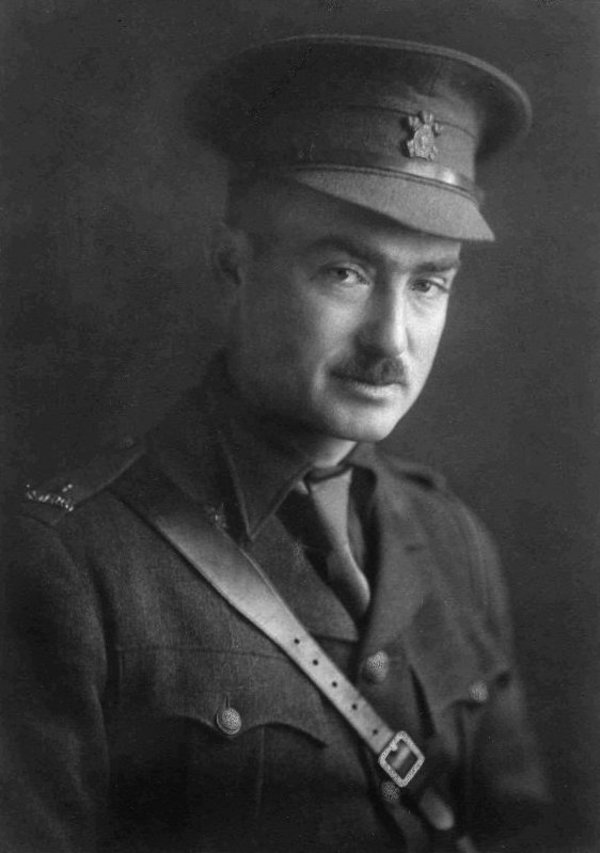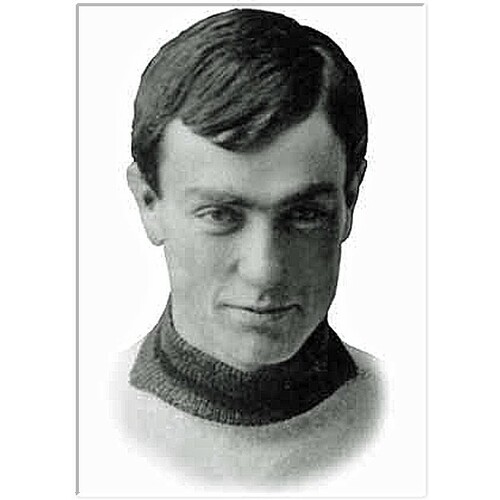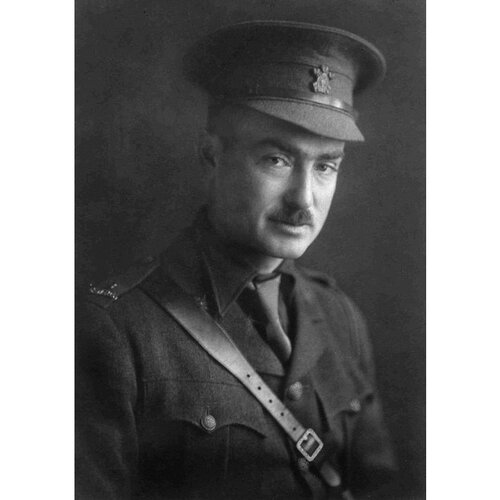
Source: Courtesy of Wikimedia Commons
RICHARDSON, GEORGE TAYLOR, athlete, merchant, and militia and army officer; b. 14 Sept. 1886 in Kingston, Ont., younger son of George Algernon Richardson, a grain merchant, and Agnes McCausland; grandson of James Richardson*; d. unmarried 9 Feb. 1916 near Wulvergem, Belgium.
George Richardson received his early education at private schools in Kingston. By the time he entered Queen’s College in 1902, he was known as an outstanding juvenile hockey player and he was immediately recruited for the college’s senior team. Together with his elder brother, James Armstrong*, George maintained an active involvement in college sports; at the same time he pursued studies in mineral engineering in order to contribute knowledgeably to a developing area of his family’s expanding commercial interests.
After graduation in 1906 he played with Kingston’s Frontenac Hockey Club, of which he was president for some years, and also appeared with the team of the 14th Regiment (The Princess of Wales’s Own Rifles), which he joined in 1907 as a provisional lieutenant. Originally at left wing, he played later on the right. Richardson was captain of the regimental team of 1908 which won the Ontario Hockey Association’s senior series. The 14th, having taken the first game 4 to 2 on home ice, beat Stratford 9 to 7 in Stratford, with Richardson accounting for 7 goals. He was added to the Queen’s College team which won the Allan Cup, for amateur senior competition in Canada, in 1909. In 1911–12 he played right wing for the Frontenacs in the OHA senior division. The team emerged undefeated from the Group 1 series, but lost the championship and the John Ross Robertson Cup to Eaton’s of Toronto. “Those who recall his play,” a Toronto newspaper columnist later remarked, “will remember how he seemed to start instantaneously at full speed in one stroke.”
Together with his brother, George assumed increasing business responsibilities in the years following his graduation. On the outbreak of World War I, by then a full lieutenant in the 14th, he volunteered for service overseas and was assigned to the 2nd Canadian Infantry Battalion. After training at Valcartier, Que., and on Salisbury Plain in England, the battalion landed in France on 11 Feb. 1915 and then entered the trenches around Armentières. Shortly thereafter it advanced to Ypres (Ieper), Belgium, where in April it suffered losses amounting to “virtual annihilation.” Having already experienced the most intense conflict, Richardson, now a captain, led a courageous but ultimately futile attempt to retake Saint-Julien (Sint Juliaan) before emerging as the sole surviving officer of No.2 Company, of which he then assumed command.
His reports from the field, detailed accounts often accompanied by constructive criticism, were well regarded by their recipients. Yet Richardson’s attention was unquestionably focused on his men, for whom he showed constant consideration and concern in matters ranging from the quality of their clothing to the design of their equipment. The responsibility was not without satisfaction, he confided to his brother. “No matter what the future may bring there will never be a position, I know, which in the way of interest and personal pleasure will compare with the task of commanding a company – an infantry company.” James was urged to see to the welfare of those who served in his brother’s company. “Part of this work,” George explained, “is accomplished by calling for volunteers and should such a thing happen as anything happening to me and some of these men who volunteered to accompany me at the same time I would like you to see that their people were looked after to the extent of a liveable income.”
On the brightly moonlit night of 8–9 Feb. 1916, having entered a snow-covered no man’s land near Wulvergem to supervise the withdrawal of a dangerously exposed raiding party, Richardson paid the ultimate price for endeavouring to ensure the safety of his fellow soldiers. He was shot through the hips and died shortly thereafter. On 17 March 1916 he was posthumously awarded the Legion of Honour.
Richardson’s will made generous provision for cultural, athletic, and charitable institutions and established a trust to provide educational support for children of those Kingston-area members of E Company (Richardson’s original company, taken into No.2) who were killed or permanently injured while on active service. In close consultation with James Richardson, the executor, and George’s sister, Agnes McCausland Etherington [Richardson*], William Folger Nickle*, who acted as trustee, arranged in 1932 for an enlargement of his powers under the trust. George Richardson’s benefaction thereafter served “to relieve the distress of those who may have been members of . . . E Company at any time while . . . [he] was a Captain thereof, the members of their families, or their dependants, giving priority from time to time, however, to the claims of those who may be in distress as a result of the war services of the members of . . . E Company.” The will also provided a sum for the advancement of cultural projects in Kingston, which were of great importance to Agnes. Under her careful stewardship this fund was used to assist Queen’s University with the acquisition of research material and artefacts.
In George’s memory, James Richardson made a substantial donation to Queen’s for the construction of a new athletic facility, the George Taylor Richardson Memorial Stadium. The Daily British Whig welcomed the splendid new facilities in 1921, noting, however, that George Richardson’s real memorial was something less tangible and more important: “It is a living thing which will perpetuate itself and keep his memory green as long as boys grow to men with sound bodies, clean minds and brave hearts. That this stadium will help them to do so is but another way of keeping George Richardson at work on earth.”
Richardson was regarded as one of the most remarkable Canadian athletes of his time, and in 1950 assumed a well-deserved place in the International Hockey Hall of Fame in Kingston. As a soldier, he was aptly described as “a man who never gave a command he would not himself have executed willingly,” and one whose conduct and character were inspirational. University colleagues said much the same, noting that he possessed “a genius for friendship; he saw the best in his friends, and that best became their standard.”
NA, RG 150, Acc. 1992–93/166. Private arch., Richardson family arch. (Winnipeg), G. T. Richardson to J. A. Richardson, 15 March, 16 Nov. 1915. Daily British Whig (Kingston, Ont.), 12 Feb. 1916, 10 Oct. 1921. H. S. Murton, “Capt. George Richardson: hero in sport and in war,” Evening Telegram (Toronto), 15 Nov. 1921: 25. Queen’s Journal (Kingston), 14 Feb. 1916, 5 March 1920. Can., Dept. of Militia and Defence, Militia list (Ottawa), 1908–14. F. C. Curry, From the St. Lawrence to the Yser with the 1st Canadian Brigade (Toronto, [1916]), 166–67. Dan Diamond and Joseph Romain, The Hockey Hall of Fame; the official history of the game and its greatest stars (Toronto, 1988). W. W. Murray, The history of the 2nd Canadian Battalion (East. Ontario Regiment), Canadian Expeditionary Force, in the Great War, 1914–1919 ([Ottawa], 1947), 54. Ont., Statutes, 1932, c.113.
Cite This Article
Jamie Benidickson, “RICHARDSON, GEORGE TAYLOR,” in Dictionary of Canadian Biography, vol. 14, University of Toronto/Université Laval, 2003–, accessed December 30, 2025, https://www.biographi.ca/en/bio/richardson_george_taylor_14E.html.
The citation above shows the format for footnotes and endnotes according to the Chicago manual of style (16th edition). Information to be used in other citation formats:
| Permalink: | https://www.biographi.ca/en/bio/richardson_george_taylor_14E.html |
| Author of Article: | Jamie Benidickson |
| Title of Article: | RICHARDSON, GEORGE TAYLOR |
| Publication Name: | Dictionary of Canadian Biography, vol. 14 |
| Publisher: | University of Toronto/Université Laval |
| Year of publication: | 1998 |
| Year of revision: | 1998 |
| Access Date: | December 30, 2025 |




